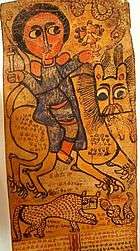Ezana of Axum
‘Ezana of Axum (Ge'ez: ዒዛና ‘Ezana, unvocalized ዐዘነ ‘zn; also spelled Aezana or Aizan) was ruler of the Kingdom of Aksum an ancient kingdom centered in what is now Eritrea and the Tigray Region of northern Ethiopia. (320s – c. 360 AD). He himself employed the style (official title) "king of Saba and Salhen, Himyar and Dhu-Raydan".[1] Tradition states that ‘Ezana succeeded his father Ella Amida (Ousanas) while still a child and his mother, Sofya served as regent.
| Ezana | |
|---|---|
 | |
| King of Aksum | |
| Predecessor | Ousanas |
| Successor | MHDYS |
| Part of a series on |
| Oriental Orthodoxy |
|---|
 |
| Oriental Orthodox churches |
|
Subdivisions
|
|
History and theology
|
|
Major figures
|
|
|
Reign
‘Ezana was the first monarch of the Kingdom of Aksum to embrace Christianity,[2] and the first after Za Haqala (possibly Zoskales) to be mentioned by contemporary historians, a situation that lead S. C. Munro-Hay to comment that he was "the most famous of the Aksumite kings before Kaleb."[3] His childhood tutor, the Syrian Christian Frumentius, became head of the Ethiopian Church. A surviving letter from the Arian Roman emperor Constantius II is addressed to ‘Ezana and his brother Saizana and requests that Frumentius be sent to Alexandria to be examined for doctrinal errors and be replaced by Theophilos the Indian; Munro-Hay assumes that ‘Ezana either refused or ignored this request.[4]
‘Ezana also launched several military campaigns, which he recorded in his inscriptions. A pair of inscriptions on a stela in Ge'ez found at Meroë is thought of as evidence of a campaign in the fourth century, either during ‘Ezana's reign, or by a predecessor like Ousanas. While some authorities interpret these inscriptions as proof that the Aksumites destroyed the kingdom of Meroë, others note that archeological evidence points to an economic and political decline in Meroë around 300.[5] Moreover, some view the stela as military aid from Aksum to Meroë to quell the revolt and rebellion by the Nuba. However, conclusive evidence and proof to which view is correct is not currently available.
On some of the Aksumite coins minted during ‘Ezana's reign appears the motto in Greek TOYTOAPECHTHXWPA – "May this please the people". Munro-Hay comments that this motto is "a rather attractive peculiarity of Aksumite coinage, giving a feeling of royal concern and responsibility towards the people's wishes and contentment".[6] A number of coins minted bearing his name were found in the late 1990s at archeological sites in India, indicating trade contacts in that country.[7] A remarkable feature of the coins is a shift from a pagan motif with disc and crescent to a design with a cross. ‘Ezana is also credited for erecting several stelae and obelisks.
Ezana is unknown in the King Lists even though the coins bear this name. According to tradition, Emperors Abreha and Asbeha ruled Ethiopia when Christianity was introduced. It may be that these names were later applied to ‘Ezana and his brother or that these were their baptismal names.[8]
Along with his brother, Saizana, ‘Ezana is regarded as a saint by the Ethiopian Orthodox Tewahedo Church, with a feast day of October 1.[9]
See also
References
- S. C. Munro-Hay, Aksum: An African Civilization of Late Antiquity (Edinburgh: University Press, 1991), p. 81. ISBN 0-7486-0106-6
- Stuart Munro-Hay (2002). Ethiopia: The Unknown Land. I.B. Tauris. p. 41.
- Munro-Hay, Aksum, p. 77
- Munro-Hay, Aksum, pp. 78ff
- Munro-Hay, Aksum, pp. 79, 224.
- Munro-Hay, Aksum, p. 192.
- Details in Paul B. Henze, Layers of Time: A History of Ethiopia (New York: Palgrave, 2000), p. 31 n.18.
- See "'Ezana" article on Dictionary of African Christian Biography (http://www.dacb.org) Web site at "Archived copy". Archived from the original on 2017-05-05. Retrieved 2017-01-04.CS1 maint: archived copy as title (link)
- Holweck, F. G., A Biographical Dictionary of the Saints. St. Louis, MO: B. Herder Book Co. 1924
Further reading
- Yuri M. Kobishchanov. Axum (Joseph W. Michels, editor; Lorraine T. Kapitanoff, translator). University Park, Pennsylvania: University of Pennsylvania, 1979. ISBN 0-271-00531-9
- Sergew Hable Sellassie. Ancient and Medieval Ethiopian History to 1270 (Addis Ababa: United Printers, 1972).
- African Zion, the Sacred Art of Ethiopia, (New Haven: Yale University Press, 1993).
